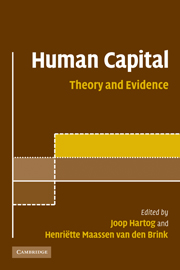Book contents
- Frontmatter
- Contents
- List of figures
- List of tables
- Notes on contributors
- Prologue
- Part I Measuring the benefits from human capital
- Part II Applying and extending the human capital model
- Part III Policy interventions
- 10 Using (quasi-)experiments to evaluate education interventions
- 11 Unemployment duration: policies to prevent human capital depreciation
- 12 Can We stimulate teachers to enhance quality?
- 13 Optimal tax and education policies and investments in human capital
- Epilogue: some reflections on educational policies
- A note on econometrics
- Index
- References
11 - Unemployment duration: policies to prevent human capital depreciation
Published online by Cambridge University Press: 22 September 2009
- Frontmatter
- Contents
- List of figures
- List of tables
- Notes on contributors
- Prologue
- Part I Measuring the benefits from human capital
- Part II Applying and extending the human capital model
- Part III Policy interventions
- 10 Using (quasi-)experiments to evaluate education interventions
- 11 Unemployment duration: policies to prevent human capital depreciation
- 12 Can We stimulate teachers to enhance quality?
- 13 Optimal tax and education policies and investments in human capital
- Epilogue: some reflections on educational policies
- A note on econometrics
- Index
- References
Summary
Introduction
European labour markets traditionally display a low inflow into unemployment and a high average duration of unemployment. Therefore, these labour markets suffer from a relatively large share of long-term unemployed workers, which is one of the main problems of European economies. Being unemployed causes loss of human capital and demotivates and stigmatizes workers, which reduces re-employment probabilities (see Frijters and Van der Klaauw, 2006; Machin and Manning, 1999). Therefore, unemployment has been an important issue for policy in the past decades.
The recession at the beginning of the 1990s induced the introduction of a large range of policy measures to help unemployed workers in finding work and to increase their human capital. In the past few years the OECD has strongly advocated active labour market programmes and the European Union adopted this as a cornerstone of macroeconomic policy in 1997. According to the OECD (2003) the total spending on active labour market policies in the European Union increased from 0.8% of GDP in 1995 to over 1% in 2001. In the Netherlands, the costs of active labour market policies are currently around 5 billion euros. Examples of these policies are training and schooling programmes, subsidized employment for youth and long-term unemployed workers, counselling and monitoring, and punitive benefit reductions. Machin and Manning (1999) argue that knowledge about the underlying unemployment dynamics is crucial in targeting active labour market programmes. In particular, programmes should be aimed at periods in which duration dependence is most pronounced.
- Type
- Chapter
- Information
- Human CapitalAdvances in Theory and Evidence, pp. 170 - 188Publisher: Cambridge University PressPrint publication year: 2007



